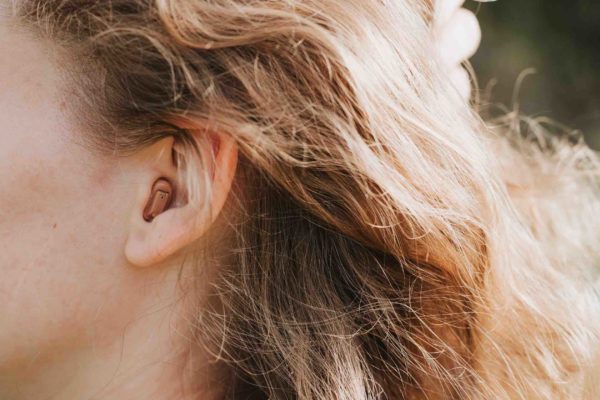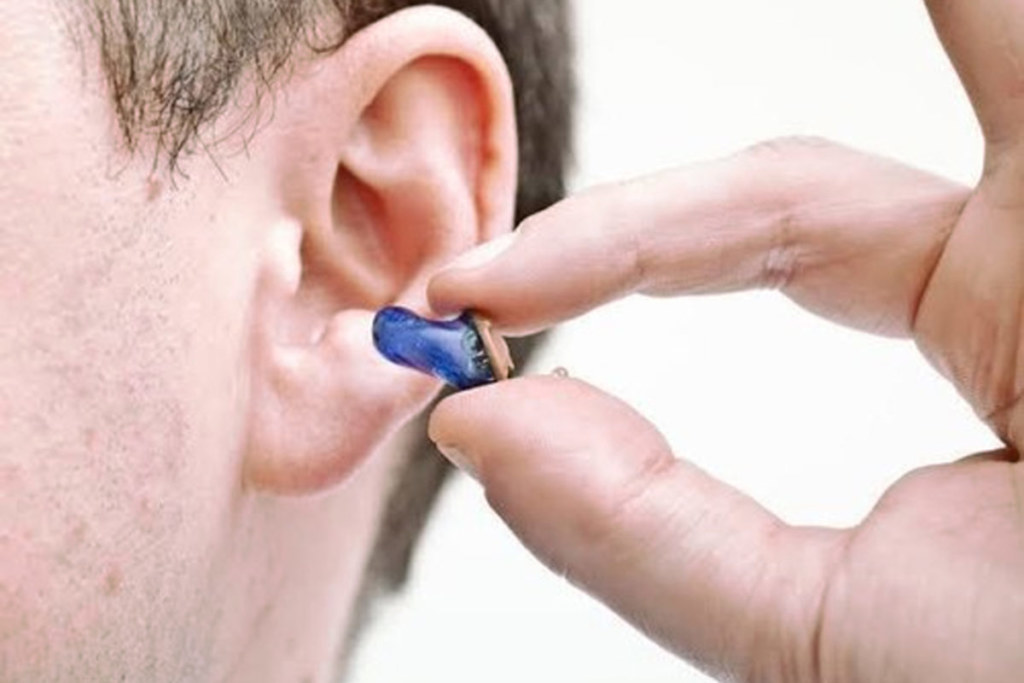Another significant barrier for hearing aid wearers is the difficulty of finding a proper fit. A poor fit can contribute to problems with hearing aids and make people less likely to wear them. In fact, research shows that people who encounter issues with their hearing aids may use them for fewer hours during the day.
Below, we share expert tips on how to put in hearing aids and ensure a comfortable fit.
Key Takeaways
- Hearing aids should fit so they are comfortable. If you’re experiencing discomfort, it’s a good idea to talk to your hearing aid provider to find out why.
- It’s important that your hearing aids are securely lodged to prevent them from falling out. If you’re experiencing issues with retention or need reinstruction on proper insertion, you should return to your health care provider.
- Be careful when removing your glasses or a mask when you are wearing behind-the-ear (BTE) hearing aids to prevent device damage.
Advice on Placing or Removing Your Hearing Aids

According to Michelle Matyko, Au.D., CCC-A, audiologist and co-owner of Roosevelt Field Hearing Corporation in Garden City, N.Y., an improperly inserted hearing aid won’t adequately amplify sound.
“The programs in the hearing aid are based on the user’s hearing levels and proper insertion,” she said.
Improperly inserted hearing aids aren’t as effective and can cause you to experience feedback. Discomfort can also occur, or they may fall out, causing you to lose them.
“Feedback occurs when sound leaks out of the ear and is re-amplified by the microphones,” said Rebecca Lewis, Au.D., audiologist and audiology director of the Adult & Pediatric Cochlear Implant Program at Pacific Neuroscience Institute at Providence Saint John’s Health Center in Santa Monica, Calif.
She added that feedback can also occur if a hearing aid is improperly placed, leaving gaps for sound to escape. A patient may also experience feedback from wax buildup.
“One last issue with proper hearing aid fit involves microphone placement. If the wire of a receiver-in-the-ear hearing aid is too long, the microphones may be oriented upward. If too short, they would be oriented downward. Ideally, you want the microphones level on the ear, so the patient hears what is in front of them,” Dr. Lewis said.
Improperly fitted hearing aids can also rub against the ear and create friction blisters.
If you are wondering how to put in hearing aids, here are some tips for how to put in different hearing aid devices.
How to Insert and Remove In-the-Ear Hearing Aids

In-the-ear hearing aids (also referred to as ITE hearing aids) are custom-created using earmold impressions to fit a specific person’s ear. “This means that they should be tightly sealed into the ear,” Dr. Lewis said.
When inserting ITE hearing aids, it’s crucial to ensure the hearing aid fits snugly into your ear. The hearing aid should follow the shape of your ear canal and feel comfortable when inserted. Nothing should stick out.
“Sometimes it helps to use a lubricant like Oto-ease to soften the ear canal before insertion to make it easier to get the hearing aid exactly where it should be.” Dr. Matyko said. “A properly placed ITE hearing aid should fit securely into the ear canal and shouldn’t come out unless you physically remove it.”
Some ITE hearing aids feature a removal string or loop to make pulling out the device easier. “Otherwise, it’s helpful to grab onto the aid and twist it forward or backward to assist in removal,” Dr. Matyko added.
“If you do not have a removal line, I would suggest pulling back on the pinnae (outer ear) to leave a gap between the hearing aid and the ear,” Dr. Lewis said. “This way you can get your finger around the hearing aid to grip it enough to twist out of the ear. When twisting it out, you might need to twist forward, toward the nose, to accommodate for the bend in the ear canal.”
How To Insert and Remove Receiver-in-Canal and Behind-the-Ear Hearing Aids

To insert receiver-in-canal (RIC) and behind-the-ear (BTE) hearing aids, Dr. Matyko suggested putting the hearing aid over the ear first, correctly positioning it before attempting to insert the receiver.
Once you’ve securely attached the over-the-ear portion, you can insert the mold or dome into your ear canal. This should help keep everything in place and prevent the hearing aid from shifting or falling out. Brian Murray, a hearing instrument specialist and workshop consultant for Alpaca Audiology, noted that lifting up on the pinna, or the visible portion of the outer ear, can help make insertion into the canal easier. “RIC hearing aids can also have a ‘sport lock’ or a retention wire that attaches to the end of the receiver and curls back into the bowl of the ear,” he said.
Removing BTE hearing aids requires first removing the mold. Dr. Matyko and Dr. Lewis both warned against removing the tube first, as this can cause it to loosen or detach from the hearing aid.
“You can take RIC hearing aids out however you feel most comfortable,” Dr. Matyko said.
During this pandemic era, RIC wearers need to be cautious when removing their masks.
“It happens far too often that an individual rips the mask off and their hearing aids come flying off as well,” Dr. Matyko said.
The same need for caution applies if you wear glasses. You need to be gentle when removing them. Careful handling can prevent hearing aid loss and damage.
How To Insert and Remove Invisible-in-Canal Hearing Aids

Dr. Lewis explained that because invisible-in-canal (IIC) and completely-in-the-canal (CIC) hearing aids are custom-molded, it’s safe to insert them deeply into the ear canal.
“Full insertion with these devices is important to get full amplification benefits and for preventing feedback,” she said.
When inserting IIC or CIC hearing aids, Dr. Matyko explained that it’s crucial to find the markers on the devices that determine the location of the top of the hearing aid. This might be a left or right marker, a serial number, or a simple dot.
This lets you know how to hold the hearing aid while inserting it. As you insert it, it’s essential to make sure it sits deeply in the ear, without causing discomfort.
“Like ITE hearing aids, these aids are an exact fit and should feel that way when inserted. They are also made to only go to a certain depth, so don’t be afraid of pushing it in. You won’t go too far,” Dr. Matyko said.
The removal string will also always be located towards the bottom of the CIC or IIC faceplate.
You’ll know you’ve pushed them in far enough when you:
- Can’t push them in further
- Don’t see parts of the hearing aid sticking out from the ear
Sometimes, you may properly insert an IIC hearing aid and still feel discomfort. When this happens, it’s a sign you need a different sized device.
“If the discomfort only happens after inserting it at home, you have most likely inserted it improperly and should remove the hearing aid and start again,” Dr. Matyko suggested. These types of hearing aids have a small antenna-looking protrusion intended to help you remove the device comfortably and with ease.
Persistent discomfort isn’t something to ignore. It’s a good idea to speak with your hearing aid provider about your issues to see if you may need fit adjustments. They can also show you how to properly insert the hearing aid.
Bottom Line
Discomfort after insertion may result from poor technique or a poorly fitting hearing aid. If you try to insert the device multiple times and continue to feel discomfort, consider getting in touch with a hearing care professional, like an audiologist, who can determine whether your hearing aid is the right fit for your ear and ear canal. “Sometimes the device may be modified in office with a Dremel to grind down the areas causing discomfort. Occasionally, they may need to be remade at the manufacturer. If there are still fit issues following a remake, new impressions may need to be taken,” Murray said.
“The key to success with hearing aids is consistent and daily hearing aid use,” Dr. Lewis said. “It takes time, patience, and practice to acclimate to hearing with hearing aids. Research demonstrates that our brain will acclimate in four-six weeks of consistent use. Of course, for some, this process may take less or more time. The longer the patient has gone without hearing sound, the longer this process may take. Again, hang in there, the first few weeks with hearing aids are the most challenging, but it does get better.”
Also, of course, proper fit and correct insertion can go a long way in ensuring consistent use.


